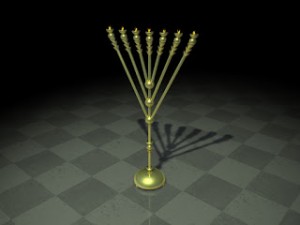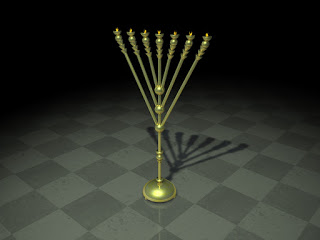
“And you shall make a menorah of pure gold, hammered out shall the menorah be made. Its base, its shaft, it cups, its knobs, and its blossoms shall be (hammered) from it.” — Shemos 25:21
Moshe Rabbeinu was charged with the construction of the Mishkan, the dwelling place of Hashem in this world. While the components of the structure are physically complex, the kavannas — the specific intentions required during the process of building it — are even more intricate.
The most complicated of all of the vessels was the menorah. Its design was so elaborate that even after Hashem taught Moshe how it was to be built, Moshe still didn’t understand its unique nature and was unable to form it. Therefore, Hashem showed Moshe an image of a menorah made of fire so that Moshe could actually see the finished form and imitate it.
Yet Rashi tells us that when it came time for the construction of the menorah, Moshe still could not fathom its structure and was unable to fabricate it. Hashem said, “Throw the clump of gold into the fire, and it will form by itself.” This is how the menorah was created — on its own.
This Rashi is perplexing. Since the menorah was so intricate that Moshe could not understand its inner nature and how to form it, then why did Hashem bother to show him the image of the menorah in fire? Hashem knew that Moshe wasn’t going to be able to create the menorah himself. He knew that in the end it would have to come about by Moshe’s throwing the clump of gold into the fire. Why did Hashem show Moshe the image of the menorah so that he should understand how it was to be formed? Clearly, creating the menorah was beyond human capacity. Why did Moshe need to have a clear image of what it was to look like?
Balance of bitachon and hishtadlus
The answer to this question is predicated on understanding the balance between Hashem’s involvement in the running of the world and man’s obligation to put in his effort — the balance between bitachon, trust and hishtadlus, effort.
One of the basic facts of life is that Hashem runs this world. While it may appear that man is in charge, Hashem orchestrates every activity on the planet. The question is: what is man’s part? If Hashem determines all outcomes, how is man supposed to act? What is his role?
How much effort should I put in?
The Chovos Ha’Levovos teaches us that we are obligated to act b’derech hatevah – in the ways of the world. In other words, we are obligated to go through the motions as if the results are dependent upon us, knowing all the while that the outcome is completely out of our hands.
We work for a living, knowing that the amount of money we are to make has been set on Rosh Hashanah. We go to doctors when we are sick, even though we know that our health is determined solely by Hashem. We put in our effort, knowing all the while that it is Hashem’s world and that He alone determines the outcome.
Amazingly, whenever we accomplish something in this world, the results are credited to us even though we are fully aware that Hashem was One Who did it all. We merely went through the motions. When we use that system, it is considered as if we did the action.
Answer: Why Moshe needed to see the image of the menorah
This seems to be the answer to the question on Rashi. Hashem wanted the Mishkan, Tabernacle and its vessels to be constructed by man. However, it was impossible for man to make them. Even the greatest of men couldn’t comprehend how to make a menorah. So his effort was to do all that he could and then rely on Hashem for the rest. Moshe would put the gold into the fire, and the menorah would form on its own. Moshe used the system that Hashem created to bring forth the menorah.
However, for the creation of the menorah to be credited to man, Moshe had to at least have a vision of what it was that he was creating. Once he had that concept in mind, throwing the clump of gold into the fire was considered as if he made the menorah himself. It was then considered as if he used Hashem’s system to bring about this result. If Moshe didn’t have a clear vision of what it was that he was creating, then in no sense could it be considered something he made — it would have been the fire that made it. Once he knew what it was that he was setting out to make, he then harnessed a force that Hashem created to bring about that result. In this case, the force was the fire bringing about the menorah.
Bitachon in our lives
This concept has great relevance to us as there are many situations in which we reach a point where there is no clear path to follow. Whether it be deciding from two almost identical career choices, determining which medical “expert” to listen to, or deciding which school to enroll our children in, we are obligated to be responsible, use our best judgment, and determine according to the ways of the world what is the best approach. Once we have reached that point, we “throw our clump of gold into the fire.” We rely on Hashem to bring about the results that He has predetermined to be the best for us.
For more on this topic please listen to Shmuz #51 – Bitachon and Hishtadlus – Finding the Balance
Rabbi Shafier is the founder of the Shmuz.com – The Shmuz is an engaging, motivating shiur that deals with real life issues.
All of the Shmuzin are available free of charge at www.theShmuz.com or on the Shmuz App for iphone or Android.


